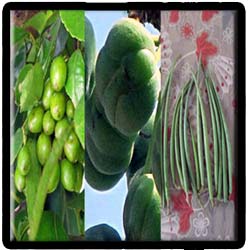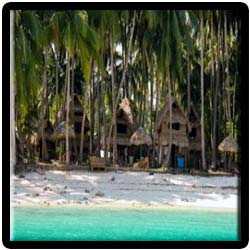CULTURE IS THE ART OF LIVING
The union territory of Andaman and Nicobar consists of a number of islands at the southeastern edge of the Bay of Bengal. However only few of the islands in Andaman and Nicobar are inhabited by human population. The people of Andaman are divided by two categories namely the indigenous tribal people and the outsiders who settled in the territory due to the fact of colonial rule. The blend of these two classes of people constitutes a colorful ethnicity to the people's profile of Andaman and Nicobar. Although the original inhabitants of this area are the aborigines, the present influence in the culture and the standard of living is due to the visitors from all over the world. The Great Andamanese are the most old tribes of this area and they belong to the Old Stone Age who had their living by hunting and fishing.
The culture of Andaman and Nicobar islands can be best expressed as comprising the following : ORIGIN AND ETHNICITY
The Onges are the people who originally belong to Africa and migrated nearly 60,000 years back. Even though there is lot of development in Andaman, they still adhere to their indigenous lifestyle. The Jarawa also having their origin from Africa are noted for their bold and violent nature. These people use iron tips to sharpen their lethal arrows mainly used for hunting.Sentinalese are the people who are still believed to go around naked living in the inaccessible coastal areas and lead their life by fishing. Mostly the people of the Nicobar island are of Mongoloid origin who are said to have migrated from Burma. The Shompens form the major group where they are further divided into Mawa Shompens and Nicobarese. The latter are known for their violent and hostile nature. When it comes to the religion at least two-thirds of the people are Hindus and one-fifth of the population are Christians and Muslims constitute one tenth.The islands of Andaman are housed by indigenous ethnic groups of people from the Indian mainland mainly Bengalis and Tamilians. People of Burma and Vietnam origin mainly comprise the Nicobar Islands. But however now there is a strict policy of outsiders not entering Nicobar Islands to protect the native tribes. Both the Andaman and Nicobar islands are noted for their pristine beaches and forests loaded with natural beauty. The people are also warm and welcoming.
CULTURE
The Andamanese have an extraordinary and rich culture and traditions. It brings a lot of visitors who are mainly attracted by the native population upholding the richness, ethnicity and customs of the islands. The native population of Andaman and Nicobar islands are constituted by two distinct groups namely the Negrito in the Andaman and Autochthones who are the Mongoloid Nicobarese and Shompen.They preserve a diverse culture with a unique style and dignity which is appreciated and attracted by the tourists. The major portion of the local people belong to the descendants who came here during early periods from the Indian mainland region. These migrants from different parts of the country add to the culture and tradition of the region and the most appreciated factor about them is that both the class of people in both the regions lives in peace and harmony preserving their culture and traditions. The tribal culture of the islanders of Andaman is comprised by the Negroids of the Paleolithic age who migrated from Africa a few thousands of years ago and further they include other ethnic groups like Andamanese, Onge, Jarawa and Sentinalese of Mongoloid origin wherein, the inhabitants of Nicobar comprise of the 'Nicobarese' and the 'Shompen' inhabitants. These tribes have maintained their uniqueness amid relative isolation and therefore have succeeded in maintaining the culture of the Islands. CLOTHING IN ANDAMAN AND NICOBAR ISLANDS
There is no specific or any modern attire which is used by the people of the Andaman and Nicobar islands for they still preserve their tradition and culture along with their language, religion and clothing styles. Though the Indian culture is refined where both the men and women wear clothes in a civilized manner, Andaman and Nicobar islands have an isolated culture of dressing up where people still hardly care for covering their body with any clothes. The Andamanese are much far away from the touch of modernity. Being far back from the present civilization and culture where the aboriginal and the Sentinelese people do not wear any clothes till recently. A slight refinement comes with the Jarawas tribe where they use only adornments of bark and shell, like necklaces, arm bands, waist bands, etc. The Shompens are semi nomadic and cover their body below the waist only. These tribes are totally detached from the civilized world. Civilization can be seen only in the Car Nicobar islands where people use modern normal attires like the rest of the world instead of their traditional dresses of those made of coconut leaves. But however all the ceremonial occasions are adorned by necklaces made of shell, waistbands and headbands of bark fiber. SOCIAL CUSTOMS AND TRADITIONS
Nature have always been a strong influence on the social customs of the Andamanese. The Ossuary Feast is one of the most important festival celebrated by the people of Nicobar islands during which the family members pay homage to the departed soul of the family. This occasion is also accompanied by Nicobarese Folk Dance where all the members of the family take part and they dance in a circular formation. It is usually celebrated on a full moon day. The men and women extend their arms across each other's back with the hand resting on the next person's shoulder. On this occasion the dancers dress themselves with the traditional costume consisting of coconut and plantain leaves around their heads and waist. This festival is also highlighted by canoe racing and a pig fight. The Great Andamanese people appreciate rhythm and time but not pitch or tune.
ARTS AND CRAFTS
The people of Andaman and Nicobar islands are known for their arts and crafts. They excel in crafts related to shells, wood, cane and bamboo. Apart from this, mat making and basketry form a traditional part of their culture. Due to the fear of over exploitation of the Islands' natural resources, trade of some products is now banned like mother-of-pearl jewellery, paduk.CUISINE

OCCUPATION



